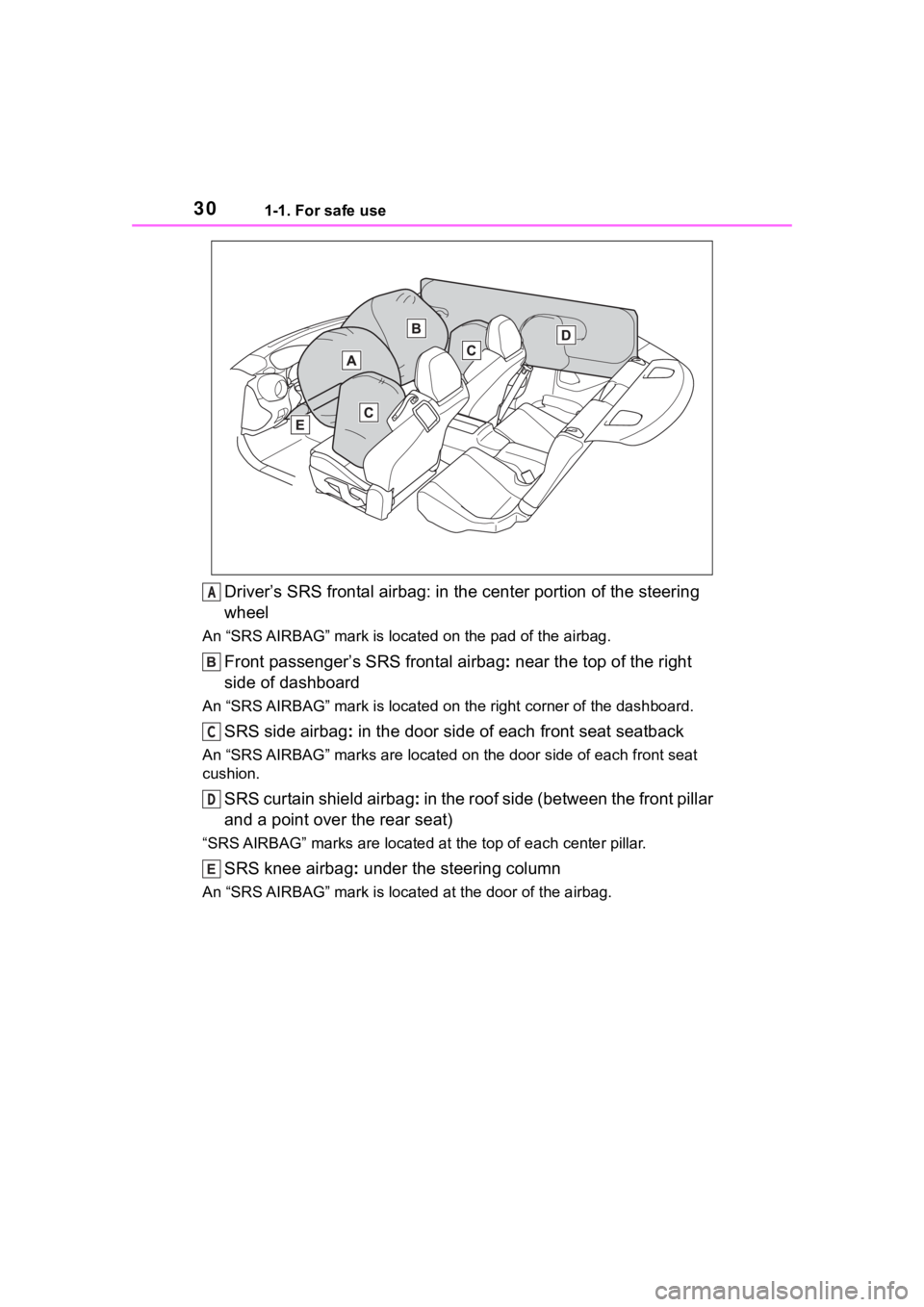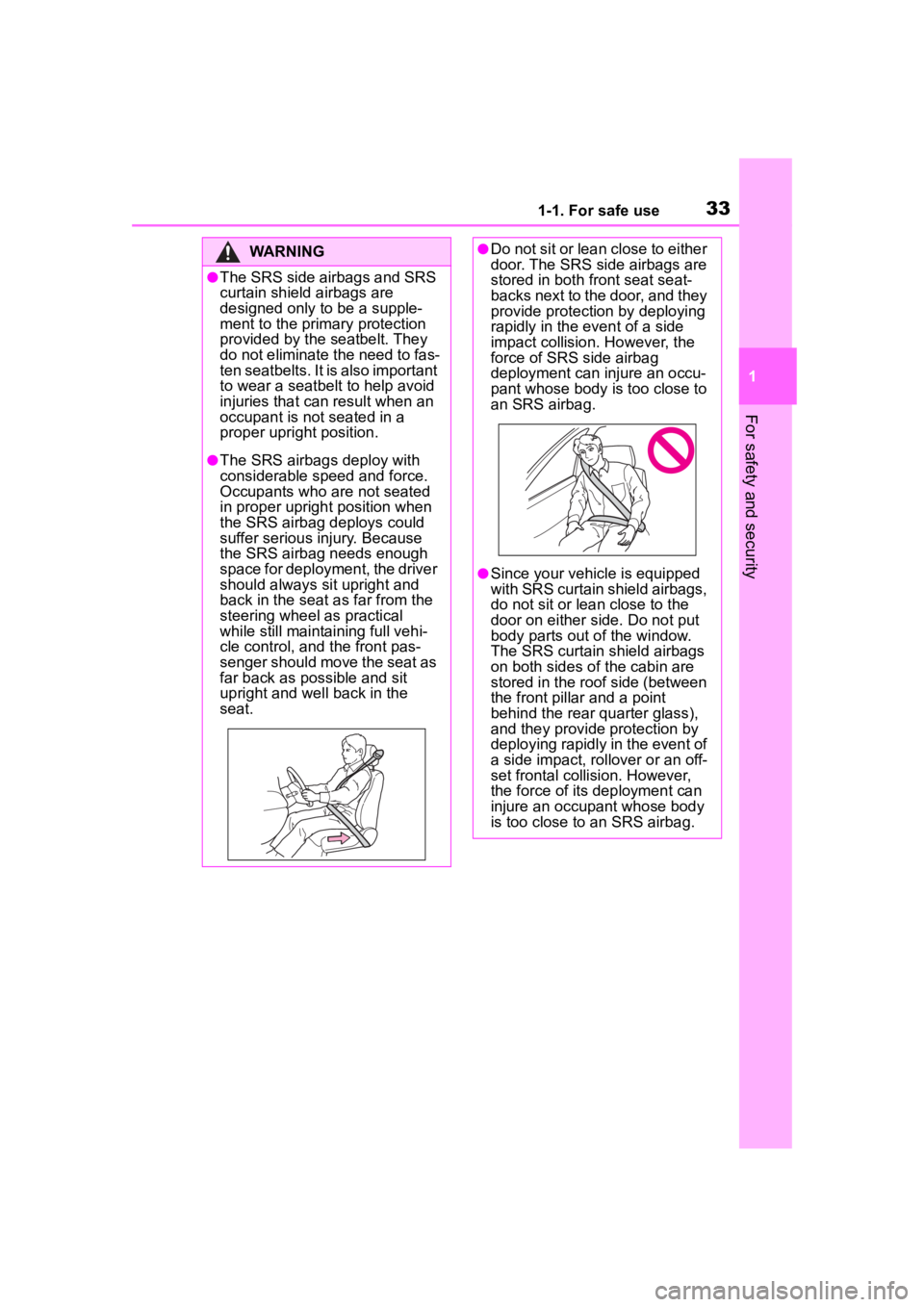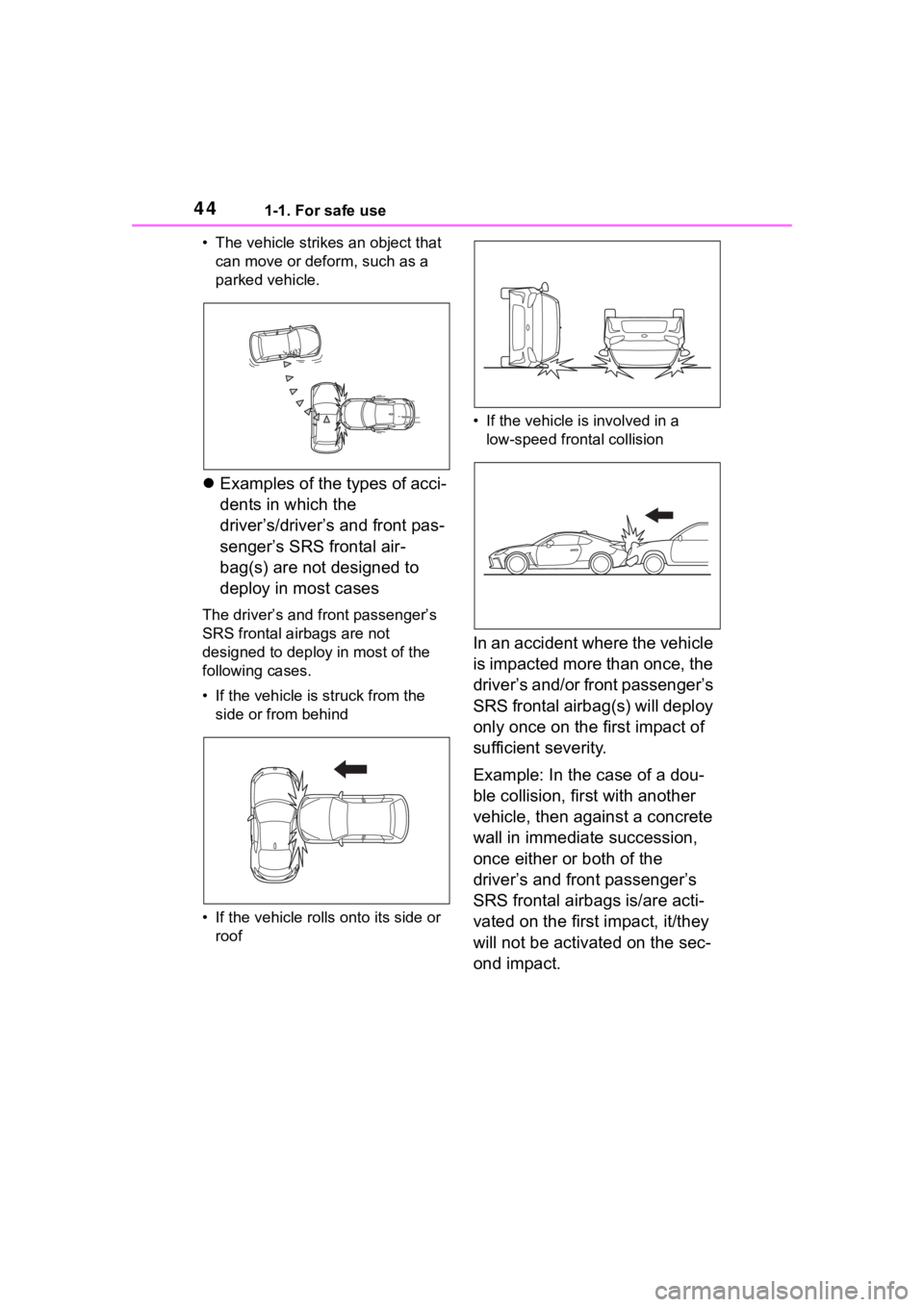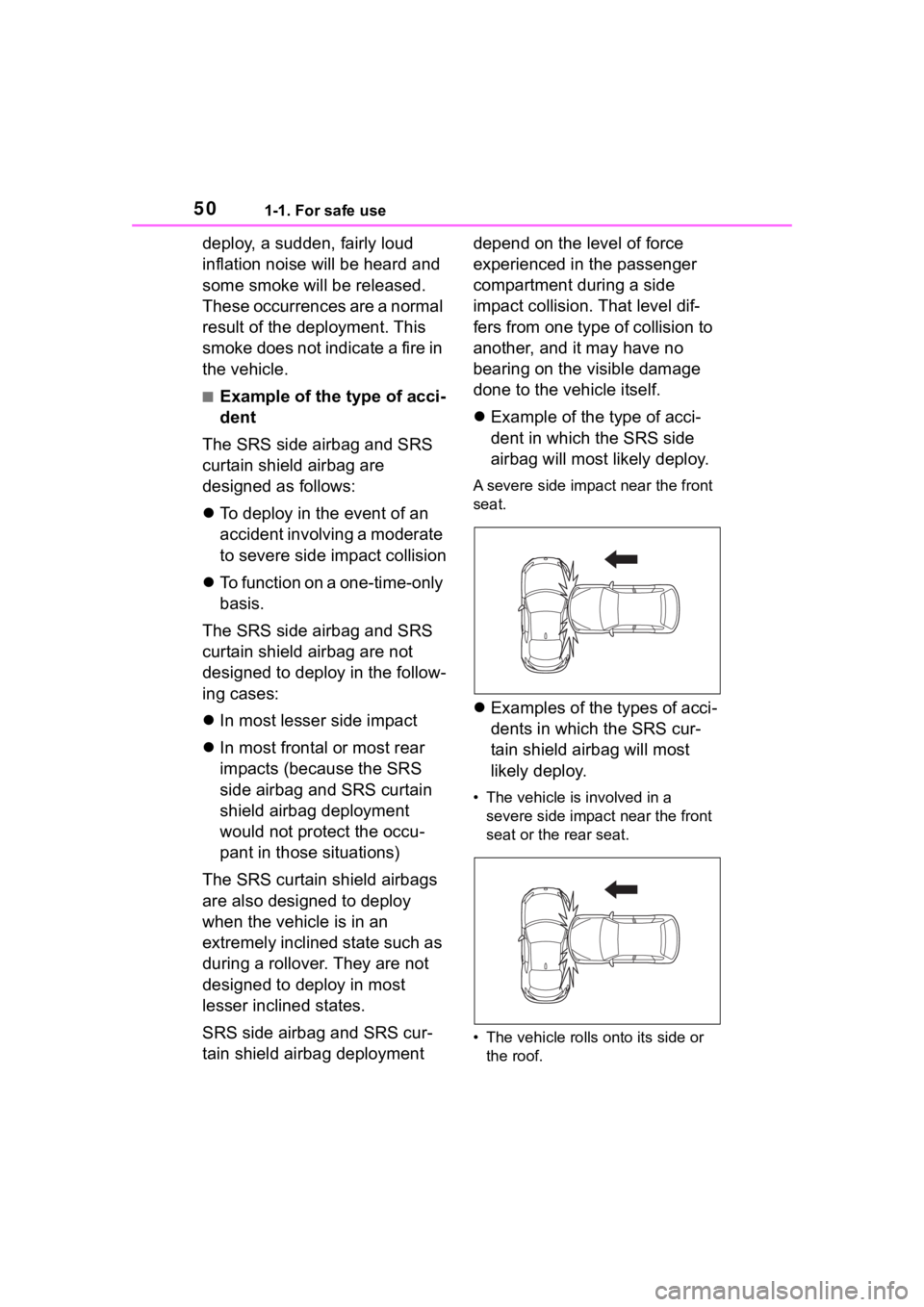2023 TOYOTA 86 roof
[x] Cancel search: roofPage 30 of 449

301-1. For safe use
Driver’s SRS frontal airbag: in the center portion of the steering
wheel
An “SRS AIRBAG” mark is loca ted on the pad of the airbag.
Front passenger’s SRS frontal airbag : near the top of the right
side of dashboard
An “SRS AIRBAG” mark is located on the right corner of the dash board.
SRS side airbag : in the door side of each front seat seatback
An “SRS AIRBAG” marks are locat ed on the door side of each front seat
cushion.
SRS curtain shield airbag : in the roof side (between the front pillar
and a point over the rear seat)
“SRS AIRBAG” marks are located a t the top of each center pillar.
SRS knee airbag: under the steering column
An “SRS AIRBAG” mark is locate d at the door of the airbag.
A
C
D
Page 32 of 449

321-1. For safe use
Side impact sensor (rear wheel house left-hand side)
Side airbag module (driver’s side)
Side impact sensor (center pillar left-hand side)
Seatbelt pretensioner (driver’s side)
Side impact sensor (door left-hand side)
Knee airbag module (driver’s side)
Curtain shield airbag module (left-hand side)
■If the SRS airbag deploys
If the SRS airbag deploys, fuel sup-
ply will be cut off to reduce the risk
of fire caused by leaking fuel. For
details about restarting of the
engine, refer to P.347.
■SRS Airbag System Servicing
In the following cases, contact your
Toyota dealer as soon as possible.
●The front part of the vehicle was
involved in an accident in which
only the driver’s SRS frontal air-
bag or both driver’s and front pas-
senger’s SRS frontal airbags did
not deploy.
●The pad of the steering wheel, the
cover over the front passenger’s
SRS frontal airbag, or either roof
side (from the front pillar to a point
over the rear seat) is scratched,
cracked, or otherwise damaged.
●The center pillar, door, rear wheel
house or rear sub frame, or an
area near these parts, was
involved in an accident in which
the SRS side air bag and SRS cur-
tain shield airbag did not deploy.
●The fabric or leather of either front
seatback is cut, frayed, or other-
wise damaged.
●The rear part of the vehicle was
involved in an accident in which
no SRS airbag was deployed.
■When you sell your vehicle
When you sell your vehicle, we urge
you to inform the buyer that the vehicle is equipped with SRS air-
bags. Also, notify the buyer of the
applicable section in this Owner’s
Manual.
WARNING
■General Precautions regard-
ing SRS Airbag System
●To obtain maximum protection
in the event of an accident, the
driver and all passengers must
always wear seatbelts when in
the vehicle. The SRS airbag is
designed only to be a supple-
ment to the primary protection
provided by the seatbelt. It does
not eliminate the need to fasten
seatbelts. In combination with
the seatbelts, it offers the best
protection in case of a serious
accident.
Not wearing a seat belt increases
the chance of severe injury or
death in a crash even when the
vehicle has the SRS airbag.
For instructions and precautions
concerning the seatbelt system,
refer to P.25.
Page 33 of 449

331-1. For safe use
1
For safety and security
WARNING
●The SRS side airbags and SRS
curtain shield airbags are
designed only to be a supple-
ment to the primary protection
provided by the seatbelt. They
do not eliminate the need to fas-
ten seatbelts. It is also important
to wear a seatbelt to help avoid
injuries that can result when an
occupant is not seated in a
proper upright position.
●The SRS airbags deploy with
considerable speed and force.
Occupants who are not seated
in proper upright position when
the SRS airbag deploys could
suffer serious injury. Because
the SRS airbag needs enough
space for deployment, the driver
should always sit upright and
back in the seat a s far from the
steering wheel as practical
while still maintaining full vehi-
cle control, and the front pas-
senger should move the seat as
far back as possible and sit
upright and we ll back in the
seat.
●Do not sit or lean close to either
door. The SRS side airbags are
stored in both front seat seat-
backs next to the door, and they
provide protection by deploying
rapidly in the event of a side
impact collision. However, the
force of SRS side airbag
deployment can injure an occu-
pant whose body is too close to
an SRS airbag.
●Since your vehicle is equipped
with SRS curtain shield airbags,
do not sit or lean close to the
door on either side. Do not put
body parts out of the window.
The SRS curtain shield airbags
on both sides of the cabin are
stored in the roof side (between
the front pilla r and a point
behind the rear quarter glass),
and they provide protection by
deploying rapidly in the event of
a side impact, rollover or an off-
set frontal collision. However,
the force of its deployment can
injure an occupant whose body
is too close to an SRS airbag.
Page 38 of 449

381-1. For safe use
WARNING
• Installation of additional electri-cal/electronic equipment such
as a mobile two-way radio on or
near the SRS airbag system
components and/or wiring is not
advisable. This could interfere
with proper operation of the
SRS airbag system.
• Modifications on or inside the door panels for the purpose of a
speaker replacement or sound
insulation
●The impact sensors, which
detect the pressure of an
impact, are located in the doors.
Do not modify any components
of the doors or d oor trims, such
as the addition of door speakers
for example. Any modifications
to the doors will create a risk of
the airbag system becoming
inoperative or unintended air-
bag deployment.
●Do not perform any of the fol-
lowing modifications. Such
modifications can interfere with
proper operation of the SRS air-
bag system.
• Attachment of any equipment (bush bar, winches, snow plow,
skid plate, etc.) other than genu-
ine Toyota accessory parts to
the front end.
• Modification of the suspension system or front end structure.
• Installation of a tire of different size and construc tion from the
tires specified on the vehicle
placard attached to the driver’s
center pillar or specified for indi-
vidual vehicle models in this
Owner’s Manual.
• Attachment of any equipment (side steps or side sill protec-
tors, etc.) other than genuine
Toyota accessory parts to the
side body.
Always consult your Toyota dealer
if you want to install any acces-
sory parts on your vehicle.
NOTICE
■SRS Airbag System Servicing
●When discarding an airbag
module or scrapping the entire
vehicle damaged by a collision,
consult your Toyota dealer.
●If you need service or repair in
areas indicated in the following
list, have the work performed by
an authorized Toyota dealer.
The SRS airbag control module,
impact sensors and airbag mod-
ules are stored in these areas.
• Under the center of the instru- ment panel
• On both the right and left sides at the front of the vehicle
• Steering wheel and column and nearby areas
• Bottom of the s teering column
and nearby areas
• Top of the dashboard on front passenger’s side and nearby
areas
• Each front seat and nearby area
• Inside each center pillar
• Inside each door
• In each roof side (from the front
pillar to a point over the rear
seat)
Page 44 of 449

441-1. For safe use
• The vehicle strikes an object that can move or deform, such as a
parked vehicle.
Examples of the types of acci-
dents in which the
driver’s/driver’s and front pas-
senger’s SRS frontal air-
bag(s) are not designed to
deploy in most cases
The driver’s and front passenger’s
SRS frontal ai rbags are not
designed to deploy in most of the
following cases.
• If the vehicle is struck from the side or from behind
• If the vehicle rolls onto its side or
roof • If the vehicle is involved in a
low-speed fron tal collision
In an accident where the vehicle
is impacted more than once, the
driver’s and/or front passenger’s
SRS frontal airbag(s) will deploy
only once on the first impact of
sufficient severity.
Example: In the case of a dou-
ble collision, first with another
vehicle, then against a concrete
wall in immediate succession,
once either or both of the
driver’s and front passenger’s
SRS frontal airbags is/are acti-
vated on the first impact, it/they
will not be activated on the sec-
ond impact.
Page 49 of 449

491-1. For safe use
1
For safety and security
on each side of the cabin is
stored in the roof side (between
the front pillar and a point over
the rear seat). An “SRS AIR-
BAG” mark is located at the top
of each center pillar.
In a moderate to severe side
i m p a c t c o l l i s i o n , t h e S R S c u r t a i n
shield airbag on the impacted
side of the vehicle deploys
between the occupant and the
side window and supplements
the seatbelt by reducing the
impact on the occupant’s head.
In a rollover, SRS curtain shield
airbags on both sides of the
vehicle deploy between the
occupant and the side window
and supplement the seatbelt by
reducing the impact to the occu-
pant’s head.
In an offset frontal collision, SRS
curtain shield airbags on both
sides of the vehicle deploy
between the occupant and the
side window and supplement
the seatbelt by reducing the
impact to the occupant’s head
and chest.
■Operation
The SRS side airbag and SRS
curtain shield airbag can func-
tion only when the engine switch
is in ON.
The following airbags deploy
independently of each other
since each has its own impact
sensor.
Driver’s SRS side airbag
Front passenger’s SRS side
airbag
SRS curtain shield airbag
(right-hand side)
SRS curtain shield airbag
(left-hand side)
Therefore, they may not both
deploy in the same accident.
Also, the SRS side airbag and
SRS curtain shield airbag
deploys independently of the
driver’s and front passenger’s
SRS frontal airbags in the steer-
ing wheel and instrument panel.
For the locations of the sensors
and control modules, refer to
P. 2 9 .
■After deployment
After the deployment, the SRS
side airbag immediately starts to
deflate. The time required from
detection of an impact to defla-
tion of an SRS side airbag after
deployment is shorter than the
blink of an eye.
The SRS curtain shield airbag
remains inflated for a while fol-
lowing deployment then slowly
deflates.
The SRS side airbag and SRS
curtain shield airbag deploy
even when no one occupies the
seat on the side on which an
impact is applied.
When the SRS side airbag and
SRS curtain shield airbag
Page 50 of 449

501-1. For safe use
deploy, a sudden, fairly loud
inflation noise will be heard and
some smoke will be released.
These occurrences are a normal
result of the deployment. This
smoke does not indicate a fire in
the vehicle.
■Example of the type of acci-
dent
The SRS side airbag and SRS
curtain shield airbag are
designed as follows:
To deploy in the event of an
accident involving a moderate
to severe side impact collision
To function on a one-time-only
basis.
The SRS side airbag and SRS
curtain shield airbag are not
designed to deploy in the follow-
ing cases:
In most lesser side impact
In most frontal or most rear
impacts (because the SRS
side airbag and SRS curtain
shield airbag deployment
would not protect the occu-
pant in those situations)
The SRS curtain shield airbags
are also designed to deploy
when the vehicle is in an
extremely inclined state such as
during a rollover. They are not
designed to deploy in most
lesser inclined states.
SRS side airbag and SRS cur-
tain shield airbag deployment depend on the level of force
experienced in the passenger
compartment during a side
impact collision. That level dif-
fers from one type of collision to
another, and it may have no
bearing on the visible damage
done to the vehicle itself.
Example of the type of acci-
dent in which the SRS side
airbag will most likely deploy.
A severe side impact near the front
seat.
Examples of the types of acci-
dents in which the SRS cur-
tain shield airbag will most
likely deploy.
• The vehicle is involved in a
severe side impact near the front
seat or the rear seat.
• The vehicle rolls o nto its side or
the roof.
Page 52 of 449

521-1. For safe use
event of accidents like those illus-
trated, the SRS side airbag may not
deploy depending on the level of
accident forces involved.
• The vehicle is involved in an oblique side-on impact.
• The vehicle is involved in a side-on impact in an area outside
the vicinity of the passenger com-
partment.
• The vehicle strikes a telephone pole or similar object.
• The vehicle is involved in a side-on impact from a motorcycle. • The vehicle rolls o
nto its side or
the roof.
Examples of the types of acci-
dents in which the SRS cur-
tain shield airbag is unlikely to
deploy.
There are many types of collisions
which might not necessarily require
SRS curtain shield airbag deploy-
ment. In the event of accidents like
those illustrated, the SRS curtain
shield airbag may not deploy
depending on the level of accident
forces involved.
• The vehicle is involved in an
oblique side-on impact.